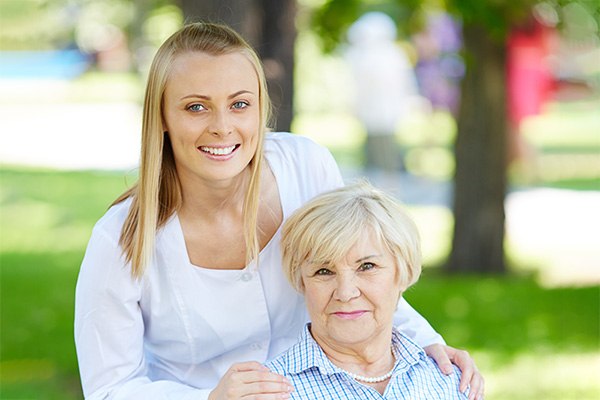Caregivers Need to Maintain Solid Relationships with Care Recipients to Maintain Better Quality of Life

When someone needs help with daily living activities or supervision due to dementia, professional caregivers can provide a better quality of life and reduce family stress. However, caregivers and care recipients should have a solid relationship.
You would think that if a caregiver and the care recipient have a good relationship, the overall quality of life for the person being cared for would be better. Research has shown this to be true. Closer caregiver-care recipient relationships are associated with stronger functional and cognitive abilities.
The bond between a caregiver and a care recipient is unique. The relationship calls for effort, patience, and so much more. However, conflicted relationships, such as distrust or disagreement in treatment plans, can lead to a further decline for the care recipient and added stress on the caregiver.
For individuals with Alzheimer's, a better relationship between the caregiver and care recipient can be even more critical. A 2009 study by Johns Hopkins and Utah State University researchers suggests that a particularly close relationship with caregivers may give individuals with Alzheimer's disease a marked edge over those without one in retaining mind and brain function over time.
Constantine Lyketsos, M.D., M.H.S., the Elizabeth Plank Althouse Professor in Alzheimer's Disease Research and director of the Johns Hopkins Memory and Alzheimer's Treatment Center, says there are clear benefits of having a caregiver with a strong relationship with the person they are caring for.
The difference in cognitive and functional decline over time between close and not-as-close pairs can mean the difference between staying at home or going to a nursing facility.
When caregivers have a good relationship with their patients, it creates a better experience. There are several ways caregivers develop a positive patient-caregiver relationship.
Family Caregivers Face Strained Relationships
Family caregivers may already have a solid relationship, but it is often strained since family caregivers are untrained and unprepared for the role. The very personal nature of being a caregiver can also be embarrassing for the care recipient when that caregiver is a loved one.
While a professional caregiver may be trained, building a solid bond will benefit both. Working as a caregiver is a fulfilling but often challenging profession. One of the most essential parts of being a caregiver is building relationships with patients and their families.
When the family is interviewing potential caregivers, they need to consider how the caregiver may get along with the potential caregiver. Family members will know whether the potential caregiver is a good match for their parent.
Families should encourage their loved one to build trust and a relationship with the caregiver as it will improve the overall quality of life. Trust is built over time, and the family should also maintain a relationship with the caregiver. The caregiver will also feel better about their role, knowing they have the family's support and involvement.
Create Conversation
Creating conversation is the first step to developing a positive caregiver-care recipient relationship. If the caregiver doesn't open up the floor for dialogue, they end up putting up a wall between them and the care recipient. This is something everyone wants to avoid.
Caregivers should engage in upbeat, casual conversation with the care recipient to learn more about them, make them feel more comfortable, and gain their trust. Families should encourage their loved one to talk and embrace the caregiver in conversation.
Dialogue is also essential when determining the needs of the care recipient. There should be a discussion of the plan of care with the care recipient and their family. The care recipient should be open to what they need so everyone can better understand. Discussion of their care plan with the caregiver helps the caregiver better understand what they need from the caregiver emotionally, physically, and mentally.
Caregivers Should Be Active Listeners
Being an active listener builds a strong caregiver-care recipient relationship. Everyone needs to listen, including the family. Caregivers should listen to what the care recipient and their family is saying.
When care recipients feel heard and understood, it makes their overall experience more enjoyable, makes their treatment more effective, improves their quality of life, and allows them to trust their caregivers more easily.
Sometimes a care recipient has difficulty speaking or struggles to get sentences out. Caregivers should be patient, giving the person their full attention to ensure they understand the concerns they are expressing. Families can be helpful as they may, especially at first, be better able to express what their loved one is trying to say.
Caregivers Should Be Kind and Empathetic
Being kind and empathetic is also essential for a good caregiver. Nobody wants a caregiver who comes across as harsh, cruel, or just downright mean. Good caregivers will be as kind as possible in every interaction with the care recipient. A good caregiver will empathize with their situation and circumstances and be as understanding as possible. It can be challenging for many care recipients to accept the fact that they need a caregiver, but it will be easier for them to make this transition into care if they have a kind and supportive caregiver who offers empathy and positivity.
Good Caregivers Respect Care Recipients Wishes
It's also necessary for a good caregiver to respect the care recipients' wishes when building a strong relationship with them. One of the significant benefits of having a good patient-caregiver relationship is that it enables the caregiver to give patients the best possible care and treatment.
The more the caregiver talks to the care recipient and listens to their wishes and concerns, the better able they are to meet their needs effectively. It's important to remember that the care recipient and their families should always have a say in their treatment and care plan. If they are uncomfortable with something a caregiver is doing, the caregiver needs to respect that and find a better solution.
The caregiver/care recipient relationship can become stressful over time. Caregivers often will need to get the person they are caring for to do things the care recipient might not want to do. The best caregivers put in a lot of effort to know their patients, improving the overall experience for everyone. The stronger the relationship, the better the overall outcome will be.
Most Long-Term Care Delivered at Home
If your loved one is experiencing declining health or aging problems, understand that most long-term health care is delivered at home. While some people may desire or need a facility like assisted living, you have many options for in-home caregivers.
Understand that long-term care services are not usually covered by health insurance or Medicare. Unless someone has a Long-Term Care Insurance policy, these costs will be paid with someone's income and assets. The LTC NEWS guide, Finding Quality In-Home Care, can be beneficial.
Medicaid will only pay for long-term health care if an individual has little or no income and assets. While it may be too late for an older loved one to obtain Long-Term Care Insurance (depending on their age and health), the ideal time to plan is when you are younger and healthy. Most people obtain coverage in their 50s. LTC Insurance will help your family address the costs and burdens of your future aging and declining health.
Enhancing Mobility and Quality of Life
Wheelchairs and scooters have become essential mobility tools for many older adults, enabling them to navigate the home environment and the outside world more easily. These devices help a care recipient restore mobility and increase independence, assisting seniors to perform daily tasks and engage in activities that might otherwise be inaccessible due to limited mobility. By restoring some measure of self-sufficiency, wheelchairs, and scooters can enhance the overall quality of life for older adults, allowing them to participate more fully in social activities and maintain connections with friends and family.
Caregivers also benefit from the mobility that wheelchairs and scooters provide to their care recipients. These devices can reduce the risk of caregiver injury and fatigue by alleviating some of the physical strain associated with assisting older adults in moving around. Caregivers can focus more on providing personalized attention and support rather than solely concentrating on physical mobility assistance, thereby enhancing the quality of care.
Furthermore, the use of wheelchairs and scooters often leads to an improvement in the mental well-being of older adults. When individuals can move about and interact with their surroundings more freely, it fosters a sense of dignity and self-worth. It helps combat feelings of isolation and dependency, creating a more positive and engaging living experience.
Lift chairs and patient lifts are also devices that can help keep a care recipient home and avoid or at least delay the need for a long-term care facility.
For older adults and their caregivers, these mobility tools represent a means of physical movement and a pathway to a more fulfilling and enriching life.


